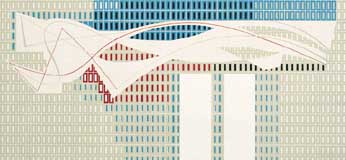|
|
|
|
|
|
|
|
|
|
|
|
|
 |
|
|
|
|
|
|
|
|
|
|
 |
Azulejo:
Original aspects of the use
of tiling in Portugal
|
 ZULEJO is a Portuguese word used to denote a square plaque of ceramic material, one side of which is decorated and glazed. ZULEJO is a Portuguese word used to denote a square plaque of ceramic material, one side of which is decorated and glazed.
Azulejos of this kind are also employed in other countries, such as Spain, Italy, Holland, Turkey, Iran and Morocco, but they occupy a particularly important place in the overall panorama of Portuguese artistic creativity:
1. Due to the fact that they have been used for five centuries without interruption.
2. Due to the way in which they are used — as a determining element in Portuguese architecture, covering large surface areas on both the inside and outside of buildings.
3. Due to the significance that has been attached to them over the centuries — they are not just seen as decorative art, but also as a basis for the display of new tastes and a record of the images in the lexicon of their users? fantasies.
|
|
|
|
|
 |
|
|
|
View of the Arab Room,
Sintra National Palace, c. 1500.
photograph: Carlos Monteiro
(DDF-IPM)
|
|
|
|
|
|
|
|
|
|
|
|
|
Design for the Passenger Terminal at Luanda Airport,
Maria Keil, 1954.
photograph: Paulo Cintra and Laura
Castro Caldas
|
|
|
 |
|
|
|
|
|
|
|
|
|
|
 |
|
|
Façade of the Viúva Lamego Factory,
Lisbon, Ferreira das Tabuletas, 1865.
photograph: Paulo Cintra and Laura Castro Caldas
|
|
|
|
|
|
|
|
|
|
|
|
|
|
|
Detail from the "Chicken's Wedding",
c. 1665, MNA cat. 400.
photograph: José Pessoa (DDF-IPM)
|
|
|
|
|
 |
|
|
|
© Instituto Camões, 2000
|
|
|
|